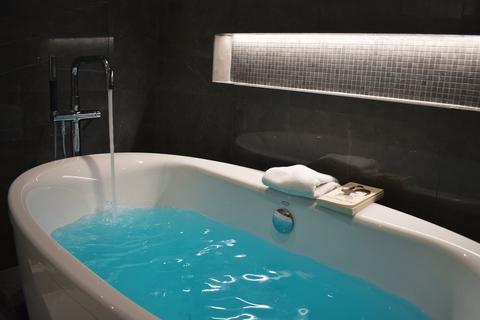Bath bombs are hard-packed mixtures of dry ingredients that effervesce when wet. They are used to add essential oils, scent, bubbles and color to bathwater. They are a mixture of salts, colorants, oils and solid items such as flower petals or glitter. When added to a bath, the sodium bicarbonate reacts with citric acid to release carbon dioxide gas (like Alka-Seltzer). As it is breaking down, it releases colorants, fragrances, salts and oils.
Potential problems
1. Solid particles in bath bombs could include natural things like lavender buds and flower petals or synthetic materials such as glitter and confetti. None of these items will dissolve. Along with the other items present in the waste stream, these could plug up plumbing and negatively affect the septic system. It is best to use bath bombs that do not contain solid particles or you could place a length of pantyhose or a fine mesh strainer over the tub drain to collect any solids. The natural products could contribute to the oxygen demand of the system and the synthetic ones could accumulate in the tank, clog effluent filters and potentially harm downstream components.
2. There are fats and oil in most bath bombs. Oils are liquid at room temperature and will make their way to the septic tank where they will hopefully float to the top and accumulate in the scum layer. Fats or butters in bath bombs can be a problem as they have a variety of melting points and if they cool too fast while traveling through the pipes, they can solidify and create a blockage similar to grease in the kitchen. Typical bathwater is usually around 105 degrees F. Cocoa butter has a melting point around 97 degrees F, but at the end of the bath, the water may have cooled to close to 98 degrees. When the drain is opened, the pipes are easily going to bring that temperature below the 97 degrees F solidification point and potentially create a buildup in the interior plumbing. Most bath bombs have such a low butter content that it should not create much of an issue in the plumbing, but if bombs are used frequently, it could accumulate in piping and the tanks outside the home. Bath “truffles” have a much higher butter content and should be avoided.
These oils and greases can accumulate in the tank, clog effluent filters or exert an additional oxygen demand in the overall system.
3. The salts used in some bath bombs may not totally dissolve. Partially dissolved bath salts can result in clogs as a few undissolved chunks can become caught in the drain, which will then catch hair and other pieces of debris. In high amounts, these added salts will harm the bacteria in the system.
In general, bath bombs are not a product recommended for frequent use for those on septic systems. For those connected to wastewater treatment plants, care should be taken to not clog drains.
About the author: Sara Heger, Ph.D., is an engineer, researcher and instructor in the Onsite Sewage Treatment Program in the Water Resources Center at the University of Minnesota. She presents at many local and national training events regarding the design, installation, and management of septic systems and related research. Heger is education chair of the Minnesota Onsite Wastewater Association and the National Onsite Wastewater Recycling Association, and she serves on the NSF International Committee on Wastewater Treatment Systems. Ask Heger questions about septic system maintenance and operation by sending an email to kim.peterson@colepublishing.com.







